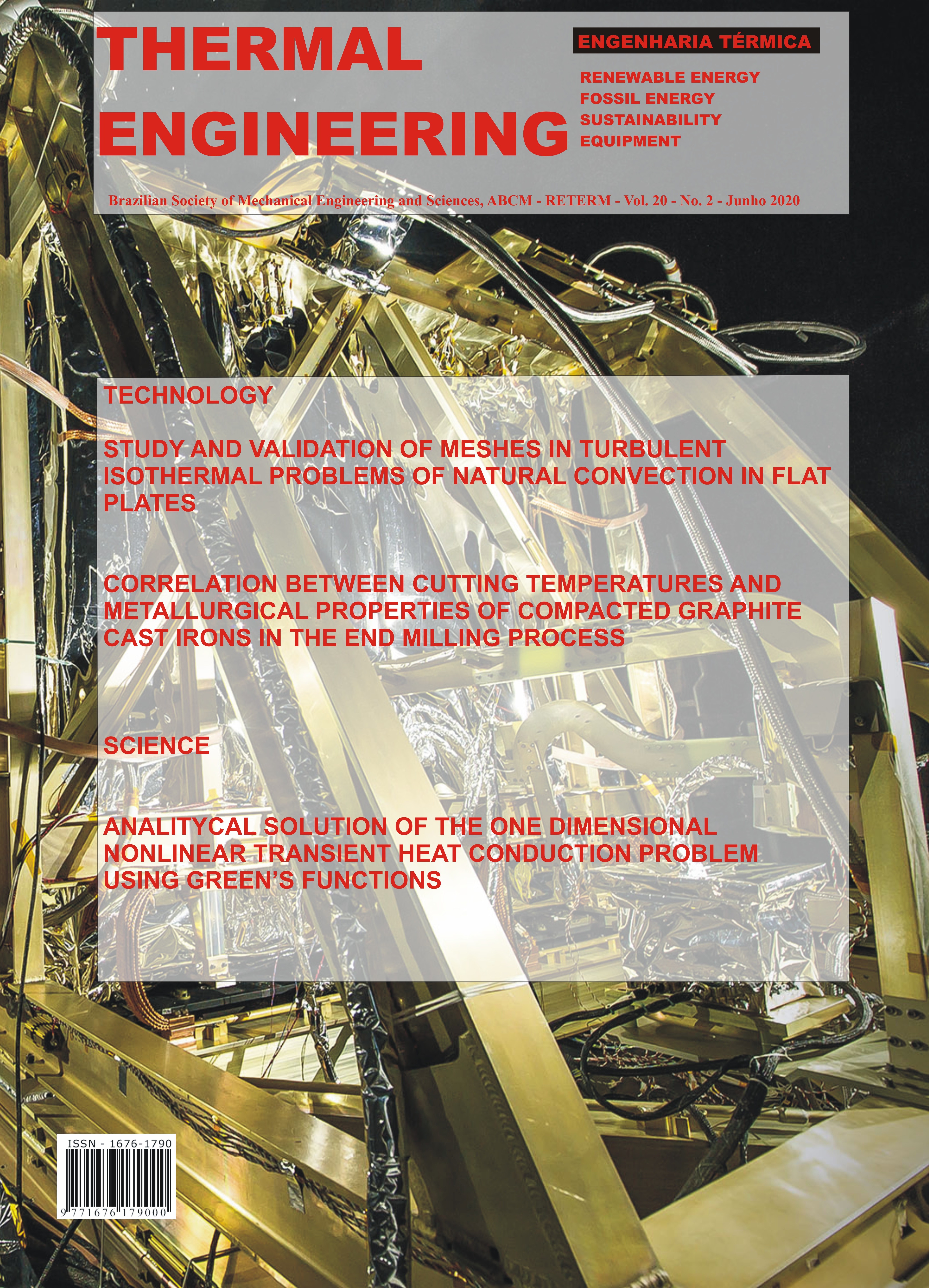| Vol.
20- No. 2 June 2021 ISSN 1676-1790 |

| AOS AUTORES FOR AUTHORS |
| EDITORIAL EDITORIAL |
| EXPEDIENTE STAFF |
| ENTRE EM CONTATO GET IN TOUCH |
| HOME |
É necessário o software Adobe Acrobat Reader ou Foxit Reader para a visualização do material pois os artigos apresentados estão no formato PDF. Clique aqui para download do Adobe |
| Parceiros |

| Editorial |
|
O editorial de Thermal Engineering deste número continua a discussão sobre as necessidades de pesquisa científica em áreas vitais em que a engenharia térmica tem participação destacada. O objetivo principal é o de motivar os leitores, dentro de suas especialidades, a identificar possíveis assuntos para sua pesquisa futura. A modelagem matemática de sistemas é uma ferramenta poderosa usada em engenharia quando você deseja projetar e otimizar equipamentos e processos. A ideia principal de um modelo matemático é ser capaz de simular com a maior precisão possível o comportamento de qualquer sistema físico, seja ele real ou virtual. No entanto, a tarefa de fazer um modelo matemático está longe de ser simples. Para efeito de comparação, a disciplina de física também propõe modelos matemáticos, mas esses modelos precisam ser universais. Na engenharia, esse grau de universalidade é praticamente impossível. Na verdade, um bom modelo matemático em engenharia é aquele que é uma boa ferramenta, auxiliando no projeto e na otimização de equipamentos e sistemas. Mas qual modelo devemos escolher quando nos encontramos em situações reais de problemas de engenharia? Infelizmente, os modelos de engenharia matemática são bastante subjetivos, levando em consideração o que cada autor viu e qual problema o autor do modelo queria resolver. É por isso que para o mesmo sistema, por exemplo trocadores de calor de casco e tubo, há uma infinidade de modelos matemáticos propostos com diferentes propostas. De modelos altamente complexos que usam dinâmica de fluidos computacional aos modelos mais simples usados em cursos de graduação. Isso requer que a criatividade e as habilidades analíticas se tornem muito importantes ao projetar e otimizar um sistema real, visto que falhas de projeto podem gerar perdas monetárias e de vidas humanas. Escolher o modelo matemático correto não é uma tarefa simples, principalmente em áreas não consolidadas, que geralmente são aquelas onde existe um grande interesse na pesquisa aplicada. O grande problema hoje é que devido a um grande número de modelos matemáticos propostos, os engenheiros geralmente optam por propor seu próprio modelo matemático. Um sistema de classificação de modelos matemáticos seria muito útil para descobrir quais modelos matemáticos são mais úteis para uma determinada situação. A missão de Thermal Engineering é a de documentar o progresso científico em áreas relacionadas à engenharia térmica (e.g., energia, petróleo, combustíveis renováveis). Nós estamos confiantes que continuaremos a receber submissões de artigos que contribuam para o progresso da ciência.
|
| Editorial |
| The editorial of Thermal Engineering of this issue continues the discussion on scientific research needs in vital areas in which thermal engineering has important participation. The main goal is to motivate the readers, within their specialties, to identify possible subjects for their future research. Mathematical modeling is a powerful tool used in engineering when one wants to design and optimize and equipment and/or processes. The main idea behind a mathematical model is to be able to simulate, as accurately as possible, the behavior of any physical system, real or virtual. However, the task of creating a mathematical model is far from simple. For the sake of comparison, disciplines of physics also propose mathematical models, but these models need to be universal. In engineering, this degree of universality is practically impossible. In reality, a good mathematical model for engineering is the one that is a good tool, assisting the design and optimization of equipment and systems. But which model should we choose when we find ourselves in real life engineering problems? Unfortunately, mathematical models for engineering are quite subjective. It takes into account what each author of the model saw and what problem he/she wanted to solve. That is why for the same system, for example, a shell and tube heat exchangers, there are multitude mathematical models proposed with different features, from highly complex models that use computational fluid dynamics to the simplest models used in undergraduate courses. This makes creativity and analytical skills very important when designing and optimizing a real system in view of the fact that design failures can generate monetary and human life losses. Choosing the right mathematical model is not a simple task, especially in unconsolidated areas, which are generally those where there is a great interest in applied research. Due to the very large number of existing mathematical models, engineers generally choose to propose their own mathematical model. A classification system formathematical modelswould be very useful to find what mathematical models are most useful for a given situation.
|
Autores/Authors | Editorial/Editorial | Contatos/Get in Touch | Expediente/Staff
Outras edições: Vol.1
- nº1 (antes Nº1), Vol.1
- nº2 (antes Nº2), Vol.1
- nº1 (antes Nº3), Vol.1
- nº1 (antes Nº4),
Vol.3
- nº1, Vol.3
- nº2, Vol.4
- nº1, Vol.4
- nº2, Vol.5
- nº1, Vol.5
- nº2, Vol.6
- nº1, Vol.6
- nº2, Vol.7
- nº1, Vol.7
- nº2,
Vol.8
- nº1, Vol.8
- nº2, Vol.9
- nº1-2, Vol.10
- nº1-2, Vol.11
- nº1-2, Vol.12
- nº1, Vol.12
- nº2, Vol.13
- nº1, Vol.13
- nº2,
Vol.14
- nº1, Vol.14
- nº2, Vol.15
- nº1, Vol.15
- nº2, Vol.16
- nº1, Vol.16
- nº2, Vol.17
- nº1, Vol.17
- nº2, Vol.18
- nº1,
Vol.18
- nº2, Vol.19
- nº1, Vol.19
- nº2.
Copyright © 2003-2021
Todos os direitos reservados